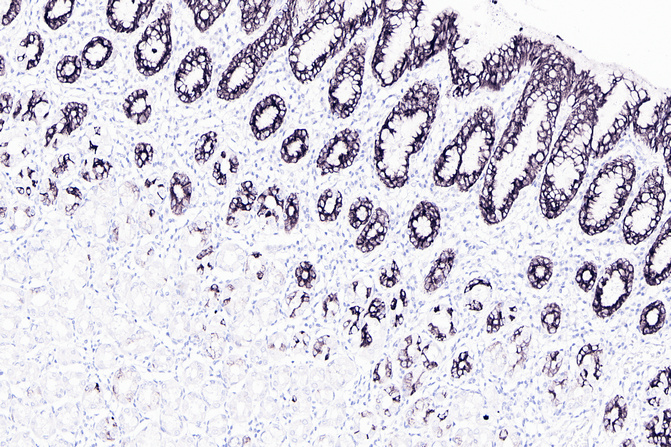MUC5AC (ABT302) IHC kit
- Catalog No.:IHCM6118
- Applications:IHC
- Reactivity:Human;
- Target:
- MUC5AC
- Fields:
- >>IL-17 signaling pathway
- Gene Name:
- MUC5AC MUC5
- Protein Name:
- Mucin-5AC (MUC-5AC) (Gastric mucin) (Lewis B blood group antigen) (LeB) (Major airway glycoprotein) (Mucin-5 subtype AC, tracheobronchial) (Tracheobronchial mucin) (TBM) (Fragments)
- Human Swiss Prot No:
- P98088
- Immunogen:
- Synthesized peptide derived from human MUC5AC AA range: 2700-2900
- Specificity:
- The antibody can specifically recognize MUC5AC protein.
- Source:
- Mouse, Monoclonal/IgG2a, kappa
- Purification:
- The antibody was affinity-purified from ascites by affinity-chromatography using specific immunogen.
- Storage Stability:
- 2°C to 8°C/1 year
- Other Name:
- Mucin-5AC;Gastric mucin;Major airway glycoprotein;Mucin-5 subtype AC, tracheobronchial;Tracheobronchial mucin;MUC5;MUC5AC
- Background:
- domain:The cysteine residues in the Cys-rich subdomain repeats are not involved in disulfide bonding.,function:Gel-forming glycoprotein of gastric and respiratoy tract epithelia that protects the mucosa from infection and chemical damage by binding to inhaled microrganisms and particules that are subsequently removed by the mucocilary system.,PTM:C-, O- and N-glycosylated. O-glycosylated on the Thr-/Ser-rich tandem repeats. C-mannosylation in the Cys-rich subdomains may be required for proper folding of these regions and for export from the endoplasmic reticulum during biosynthesis.,PTM:Proteolytic cleavage in the C-terminal is initiated early in the secretory pathway and does not involve a serine protease. The extent of cleavage is increased in the acidic parts of the secretory pathway. Cleavage generates a reactive group which could link the protein to a primary amide.,similarity:Contains 1 CTCK (C-terminal cystine knot-like) domain.,similarity:Contains 2 VWFC domains.,similarity:Contains 4 VWFD domains.,subunit:Multimeric. Interacts with H.pylori in the gastric epithelium, Barrett's esophagus as well as in gastric metaplasia of the duodenum (GMD).,tissue specificity:Highly expressed in surface mucosal cells of respiratory tract and stomach epithelia. Overexpressed in a number of carcinomas. Also expressed in Barrett's esophagus epithelium and in the proximal duodenum.,
- Function:
- domain:The cysteine residues in the Cys-rich subdomain repeats are not involved in disulfide bonding.,function:Gel-forming glycoprotein of gastric and respiratoy tract epithelia that protects the mucosa from infection and chemical damage by binding to inhaled microrganisms and particules that are subsequently removed by the mucocilary system.,PTM:C-, O- and N-glycosylated. O-glycosylated on the Thr-/Ser-rich tandem repeats. C-mannosylation in the Cys-rich subdomains may be required for proper folding of these regions and for export from the endoplasmic reticulum during biosynthesis.,PTM:Proteolytic cleavage in the C-terminal is initiated early in the secretory pathway and does not involve a serine protease. The extent of cleavage is increased in the acidic parts of the secretory pathway. Cleavage generates a reactive group which could link the protein to a primary amide.,similarity:Conta
- Subcellular Location:
- Cytoplasmic
- Expression:
- Highly expressed in surface mucosal cells of respiratory tract and stomach epithelia. Overexpressed in a number of carcinomas. Also expressed in Barrett's esophagus epithelium and in the proximal duodenum.
- June 19-2018
- WESTERN IMMUNOBLOTTING PROTOCOL
- June 19-2018
- IMMUNOHISTOCHEMISTRY-PARAFFIN PROTOCOL
- June 19-2018
- IMMUNOFLUORESCENCE PROTOCOL
- September 08-2020
- FLOW-CYTOMEYRT-PROTOCOL
- May 20-2022
- Cell-Based ELISA│解您多样本WB检测之困扰
- July 13-2018
- CELL-BASED-ELISA-PROTOCOL-FOR-ACETYL-PROTEIN
- July 13-2018
- CELL-BASED-ELISA-PROTOCOL-FOR-PHOSPHO-PROTEIN
- July 13-2018
- Antibody-FAQs
- Products Images

- Human stoamch tissue was stained with MUC5AC (ABT302) Antibody



